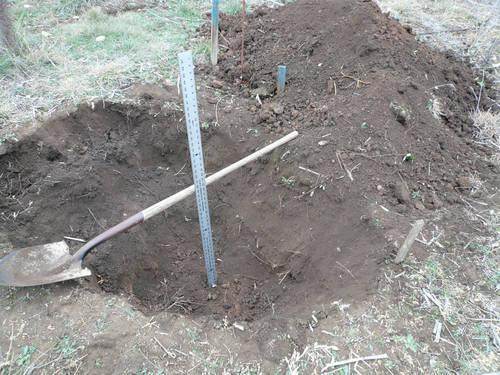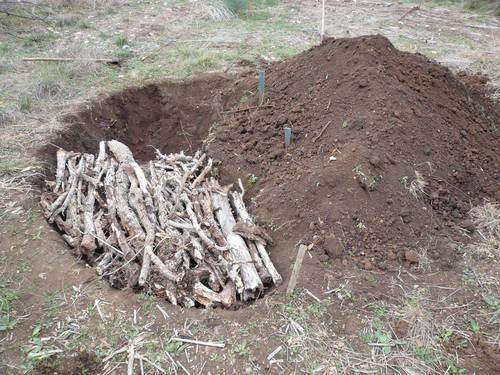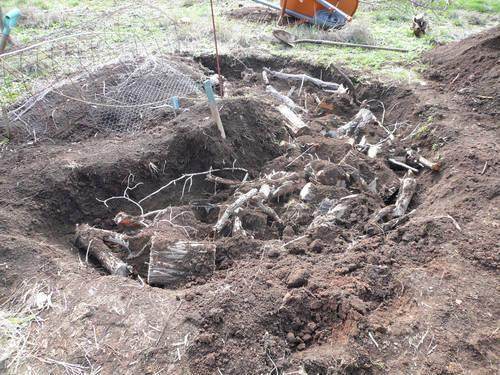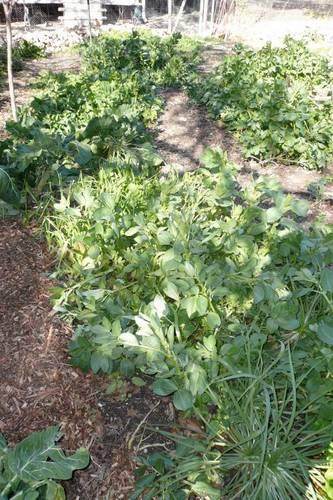
 1
1




 1
1




 2
2








Idle dreamer




C.J. Murray wrote:I too struggle with keeping things moist and I am going to try several different strategies incorporating rotting wood including raised bed, level bed and burying the logs below walkways to, over time, create a noncompactable walkway also capable of absorbing/storing moisture. As it is now my walkways become hard deserts and I'm sure this impacts root growth on adjacent plants.
 1
1




Idle dreamer




Tyler Ludens wrote:In the picture above of the kitchen garden, the entire area is buried wood, including the paths. I can't decide if I want to do the other garden that way or leave the paths just soil....
 1
1




Idle dreamer




Never doubt that a small group of dedicated people can change the world, Indeed it is the only thing that ever has. Formerly pa_friendly_guy_here





Idle dreamer




Buy Our Book! Food Web: Concept - Raising Food the Right Way. Learn make more food with less inputs
Off Grid Homesteading - latest updates and projects from our off grid homestead




Abe Connally wrote:I, for one, would love to see this in practice in my semi-arid climate. I'm sure it works great for folks that have plenty of trees they can cut down, but we can't afford anymore deforestation in the name of agriculture here. Without wood, does it work? Are there alternatives to wood?
So, how can we implement these methods on brittle/dry lands (the vast majority of the world's land)?




Abe Connally wrote:
So, how can we implement these methods on brittle/dry lands (the vast majority of the world's land)?
Idle dreamer




Buy Our Book! Food Web: Concept - Raising Food the Right Way. Learn make more food with less inputs
Off Grid Homesteading - latest updates and projects from our off grid homestead
 1
1




Idle dreamer




"Limitation is the mother of good management", Michael Evanari
Location: Southwestern Oregon (Jackson County), Zone 7




Buy Our Book! Food Web: Concept - Raising Food the Right Way. Learn make more food with less inputs
Off Grid Homesteading - latest updates and projects from our off grid homestead








sheryl hansen wrote:
Abe, in what specific cases would burried wood prevent the soil from absorbing moisture? All I can think of is that the hugelbed would absorb so much moisture that less would be available for the surrounding soil.
Buy Our Book! Food Web: Concept - Raising Food the Right Way. Learn make more food with less inputs
Off Grid Homesteading - latest updates and projects from our off grid homestead
 1
1




Idle dreamer









Never doubt that a small group of dedicated people can change the world, Indeed it is the only thing that ever has. Formerly pa_friendly_guy_here




Marianne West wrote:

this is a picture of Sepp Holzer's work in spain. Looks like a hugelbed to me.
for many more pics go here http://www.krameterhof.at/Fotoalbum/spanien_2006/index.htm
Buy Our Book! Food Web: Concept - Raising Food the Right Way. Learn make more food with less inputs
Off Grid Homesteading - latest updates and projects from our off grid homestead




Idle dreamer




Tyler Ludens wrote:The picture does not look like a "desert" to me. That looks a lot more like our area than like yours, Abe! Plus Spain is WAY far north compared to you. People just don't appreciate the importance of latitude to the issue of rainfall and evaporation. Much of England gets around the same amount of rainfall as Central Texas. Seems like I hardly need mention Central Texas does NOT look like England. What you and I would like to see, I bet, is someone successfully practicing these techniques in North Africa. I'm at the same latitude as Cairo, Egypt, and you're south of me.
Buy Our Book! Food Web: Concept - Raising Food the Right Way. Learn make more food with less inputs
Off Grid Homesteading - latest updates and projects from our off grid homestead




Abe Connally wrote:
Tyler Ludens wrote:The picture does not look like a "desert" to me. That looks a lot more like our area than like yours, Abe! Plus Spain is WAY far north compared to you. People just don't appreciate the importance of latitude to the issue of rainfall and evaporation. Much of England gets around the same amount of rainfall as Central Texas. Seems like I hardly need mention Central Texas does NOT look like England. What you and I would like to see, I bet, is someone successfully practicing these techniques in North Africa. I'm at the same latitude as Cairo, Egypt, and you're south of me.
Yeah, that's right, something in North Africa would be very useful. We were part of the same drought that hit, you, too, so things that work for you usually work for us.




Abe Connally wrote:
sheryl hansen wrote:
Abe, in what specific cases would burried wood prevent the soil from absorbing moisture? All I can think of is that the hugelbed would absorb so much moisture that less would be available for the surrounding soil.
It shouldn't prevent the soil from absorbing moisture, but it has to have moisture to absorb. So, the little rainfall that is received must make its way down through everything to get to the wood. This may not be the most appropriate thing in a dry climate. Even clay soil on top of the pile would prevent some absorption.




Marianne West wrote: his project in Spain has about 12" of rainfall,
Idle dreamer




12 inches in Spain is probably double the "rain value" of 12 inches in Mexico.
Buy Our Book! Food Web: Concept - Raising Food the Right Way. Learn make more food with less inputs
Off Grid Homesteading - latest updates and projects from our off grid homestead
















The project in Portugal is at 28 degree latitude
Also, the trees you are admiring in the Spain project - they were all dying. The are stone oak which live 100s of years and they were dying because the area was turning into a desert.
Buy Our Book! Food Web: Concept - Raising Food the Right Way. Learn make more food with less inputs
Off Grid Homesteading - latest updates and projects from our off grid homestead








Buy Our Book! Food Web: Concept - Raising Food the Right Way. Learn make more food with less inputs
Off Grid Homesteading - latest updates and projects from our off grid homestead




The project in Portugal is at 28 degree latitude
Portugal is 37-42 degrees.
I am 29.
You are right. I got the Spain project mixed up with Portugal. It is in Tenerife at 28 latitude.
And yes, you are much higher.
it seems that what we are learning here is that we just have to try it out and share what happens. We already know that the sunken ones seem to work well - don't know how a raised one would have done in the same area. looks like only one way to find out - doing it.....




Buy Our Book! Food Web: Concept - Raising Food the Right Way. Learn make more food with less inputs
Off Grid Homesteading - latest updates and projects from our off grid homestead




A pair a what shift?




Buy Our Book! Food Web: Concept - Raising Food the Right Way. Learn make more food with less inputs
Off Grid Homesteading - latest updates and projects from our off grid homestead




Idle dreamer




Buy Our Book! Food Web: Concept - Raising Food the Right Way. Learn make more food with less inputs
Off Grid Homesteading - latest updates and projects from our off grid homestead

|
this tiny ad is a cult leader
The new gardening playing cards kickstarter is now live!
https://www.kickstarter.com/projects/paulwheaton/garden-cards
|






